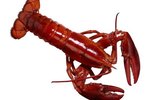
The short-beaked common dolphin was once the most common dolphin species in the Mediterranean. Until recently, this dolphin species thrived in abundant numbers from the Straits of Gibraltar to Greece and Turkey. Sadly, this lovely creature is now seriously endangered, and the small population is seen in only a few parts of his former range. Visitors to southern Spain and the Greek island of Kalamos are likely to see schools of them not far from shore.
Short-Beaked Common Dolphin
The short-beaked common dolphin -- usually shortened to common dolphin, or Delphinus delphis, as he's known scientifically -- averages nine feet in length and weighs some 440 pounds. Common dolphins in he Mediterranean may be somewhat smaller than their Atlantic and Pacific cousins due to a reduction in available food -- one of the reasons he's listed as endangered by the International Union for the Conservation of Nature. Usually this dolphin thrives as long as he has warm water and plenty to eat. Typically, he doesn't like to stray far from home, unless he's forced to by cold water or lack of food. Even then he returns to his home range as soon as possible.
Distribution in the Mediterranean
The common dolphin's range in the Mediterranean stretches from Gibraltar, where the Med meets the Atlantic, to the shores of Lebanon at the eastern end of the region. They also appear along the North African coast from Morocco to Egypt. However, the IUCN reports there are only two locations where you can see substantial populations: the Alboran Sea off Spain's Costa del Sol and Costa Blanca, which form the main part of Andalucia's coastline, and around the Ionian island of Kalamos in Greece. The common dolphins found in the Alboran Sea show some signs of sharing genetics with the Atlantic common dolphins, but researchers use the differences between Alboran and Atlantic dolphins as the basis of the claim for a Mediterranean subspecies.
Behavior
Typically this dolphin likes to live in schools of 50 to 70, but the IUCN says it's more usual now to see schools as small as 15 and certainly no larger than 40. They have an ordered hierarchy, according to Dolphin World, and a school usually subdivides into smaller groups based on age and possibly other factors. They are energetic and playful, and love to breach the water, somersault and even tease each other.
Threats
The IUCN suggests that human impact and climate change have affected the Mediterranean's biodiversity, and these are the source of the common dolphin's decline. Drift net fishing in the Alboran Sea used to kill several hundred dolphins annually until this type of fishing was stopped in 1999; the IUCN suspects the same fishing problem exists in other parts of the Mediterranean. The IUCN also reports that Mediterranean dolphins have higher levels of PCB chemicals compared to common dolphins elsewhere -- skin biopsies revealed that these have affected the dolphins' endocrine system. Added to these issues, striped and bottlenose dolphins are on the rise in the Mediterranean, and that competition for habitat may threaten the common dolphins' environment by forcing him to move elsewhere.
References
Photo Credits
-
Goodshoot/Goodshoot/Getty Images
Writer Bio
Based in London, Eleanor McKenzie has been writing lifestyle-related books and articles since 1998. Her articles have appeared in the "Palm Beach Times" and she is the author of numerous books published by Hamlyn U.K., including "Healing Reiki" and "Pilates System." She holds a Master of Arts in informational studies from London University.




